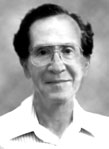
2001 - 2002
Bell Laboratories - Lucent Technologies
"...for fundamental contributions to the understanding of the optical properties of quantum wells and semiconductor lasers."
For more than 30 years Charles H. Henry led research groups in optoelectronics at the Physics Research Division of Bell Laboratories, where he turned out a steady stream of new discoveries, observations and theories. His work bridges the gap between physics and engineering and demonstrates a rare mastery of both theory and experiment.
Henry was born in Chicago in 1937. He earned a M.S. degree from the University of Chicago in 1959 and a Ph.D. from the University of Illinois in 1965, both in physics.
In the early 1970s, Henry realized that if the light-emitting active layer of a semiconductor laser were made extremely thin, the optical absorption edge would be transformed by quantum effects from a smoothly increasing function into a series of steps. After these steps were observed, he also realized that these changes would result in a semiconductor laser with improved performance and he and a colleague filed a patent on what is now called the "quantum well laser." Most modern semiconductor lasers employ quantum wells.
Henry is well known for his work in the early 1980s establishing the "alpha parameter" as a key parameter of semiconductor lasers. His paper on this topic has been cited over 500 times due to the importance of this parameter in determining the line broadening and frequency modulation of these lasers. It is now part of the standard description of semiconductor lasers.
More recently, Henry concentrated on developing a new way of making integrated optical circuits, in which the optical waveguides are fabricated with silicon technology. This pioneering research came to be called silicon optical bench waveguide technology. It is used to make array waveguide multiplexers that cleanly separate many optical signals at different wavelengths that are travelling on the same optical fiber. Today, this technology is widely used in fiber optic telecommunications.
The broad influence of Henry's career in optoelectronics was recognized in 1999 by two distinguished prizes in engineering, the Jack A. Morton Award of the Institute of Electrical and Electronics Engineers and the Charles Hard Townes Award of the Optical Society of America. He received the College of Engineering Alumni Award for Distinguished Service from the University of Illinois earlier this year. He is a Fellow of the APS, the IEEE, and the AAAS.
Henry retired from Bell Laboratories in 1997 as a Distinguished Member of Technical Staff. He continues his association with Bell Labs as a consultant.
